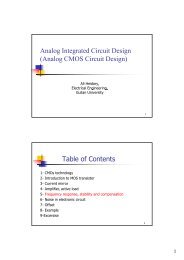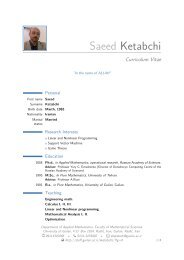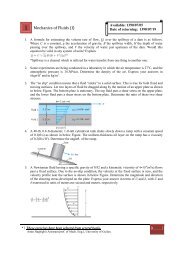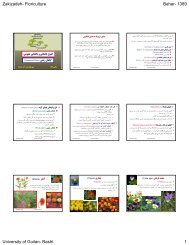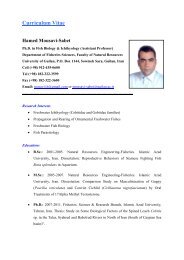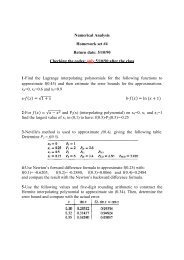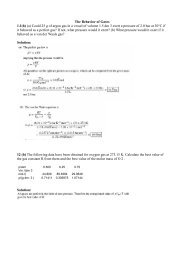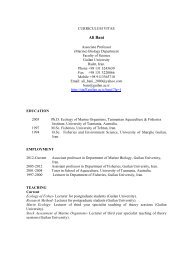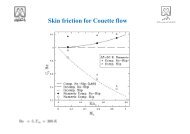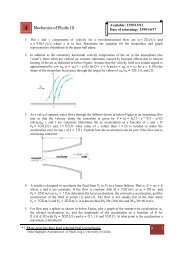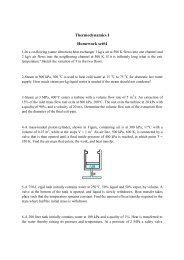Notes ● 19340. UNCTAD Secretariat, “International Trade <strong>in</strong> Health Services: Difficulties andOpportunities for Develop<strong>in</strong>g <strong>Countries</strong>,” <strong>in</strong> UNCTAD International Trade <strong>in</strong>Health Services, p. 5.41. Ibid, pp. 11–12.42. J. Diamond, “International <strong>Tourism</strong> and the Develop<strong>in</strong>g <strong>Countries</strong>: a CaseStudy <strong>in</strong> Failure,” Economica Internazionale, 27, no. 3–4, 1974.43. Woodward et al., “Globalization, Global Public Goods and Health,” p. 5.44. World Bank, Susta<strong>in</strong><strong>in</strong>g India’s Services Revolution, pp. 17–18.45. The Harrod-Domar model is named after two economists, Roy Harrod andEvesey Domar who concurrently, but separately, developed the theory <strong>in</strong> the1950s.46. Arthur Lewis, “Economic Development with Unlimited Supplies of Labour,”The Manchester School 22 (1954); and Albert Hirshman, The Strategy ofEconomic Development (New Haven, CT: Yale University Press, 1958).47. Gerald Meier and James Rauch, Lead<strong>in</strong>g Issues <strong>in</strong> Economic Development, 8th ed.(New York: Oxford University Press, 2005), p. 293.48. Robert Lucas, “On the Mechanics of Economic Development,” Journal ofMonetary Economics 22, no. 1 (1988); and Paul Romer, “Increas<strong>in</strong>g Returns andLong Run Growth,” Journal of Political Economy 94, no. 5 (1986).49. G. M. Grossman and E. Helpman, “Endogenous Innovations <strong>in</strong> the Theory ofGrowth,” Journal of Economic Perspectives 8 (1994).50. Accord<strong>in</strong>g to the UNWTO, tourism is more labor <strong>in</strong>tensive than manufactur<strong>in</strong>g,although not as much as agriculture (David Diaz Benavides and Ellen Perez-Ducy, eds., “Background Note by the OMT/WTO Secretariat,” <strong>Tourism</strong> <strong>in</strong> theLeast Developed <strong>Countries</strong> (Madrid: UNWTO, 2001)).51. Anil Markandya, Tim Taylor, and Suzette Pedroso, “<strong>Tourism</strong> and Susta<strong>in</strong>ableDevelopment: Lessons From Recent World Bank Experience,” www.pigliaru.it/chia/markandya.pdf, pp. 10–12, accessed January 20, 2005.52. Benavides and Perez-Ducy, “Background Note.”53. See, among others, Paul Baran, The Political Economy of NeoColonialism(London: He<strong>in</strong>eman, 1975); Hans S<strong>in</strong>ger, “Dualism Revisited: A New Approachto the Problems of Dual Societies <strong>in</strong> Develop<strong>in</strong>g <strong>Countries</strong>,” Journal ofDevelopment Studies 7 (January 1970); Keith Griff<strong>in</strong> and John Gurley, “RadicalAnalysis of Imperialism, the Third World, and the Transition to Socialism:A Survey Article,” Journal of Economic Literature 23 (September 1985);Theotonio dos Santos, “The Crisis of Development Theory and the Problemof Dependence <strong>in</strong> Lat<strong>in</strong> America,” Siglo 21 (1969); and Benjam<strong>in</strong> Cohen, TheQuestion of Imperialism: The Political Economy of Dom<strong>in</strong>ance and Dependence(New York: Basic Books, 1973).54. Dudley Seers, Dependency Theory: A Critical Reassessment (London: FrancisPr<strong>in</strong>ter, 1983), p. 97.55. S. Britton, “The Political Economy of <strong>Tourism</strong> <strong>in</strong> the Third World,” Annals of<strong>Tourism</strong> Research 9, no. 3 (1982).56. C. Michael Hall and Hazel Tucker, eds., <strong>Tourism</strong> and Postcolonialism (London:Routledge, 2004).
194 ● Notes57. Economist, July 31, 2004, p. 33.58. Jozsef Borocz, Leisure Migration. A Sociological Study on <strong>Tourism</strong> (Tarrytown,NY: Elsevier, 1996), p. 12.59. Lea, <strong>Tourism</strong> and Development, p. 13.60. Cynthia Enloe, Bananas, Beaches and Bases, p. 31.61. See, among others, Rodney Falvey and Normal Gemmer, “Are Services IncomeElastic: Some New Evidence,” The Review of Income and Wealth 42 (September1996).62. Geoffrey Crouch, “Demand Elasticities for Short-Haul versus Long-Haul<strong>Tourism</strong>,” Journal of Travel Research, 33 no. 2 (1994).63. S<strong>in</strong>clair and Stabler, The Economics of <strong>Tourism</strong>, p. 15. Also, see Larry Dwyer,Peter Forsyth, and Prasada Rao, “Dest<strong>in</strong>ation Price Competitiveness: Exchange RateChanges versus Domestic Inflation,” Journal of Travel Research 40, no. 3 (2002).64. Hendrick Houthakker and Lester Taylor, Consumer Demand <strong>in</strong> the UnitedStates: Analysis and Projections (Cambridge: Harvard University Press, 1970).65. S<strong>in</strong>clair and Stabler, The Economics of <strong>Tourism</strong>, p. 149.66. Crist<strong>in</strong>a Rennhoff (lecture at St. Joseph’s University, Philadelphia, PA, March2005).67. Scholars have made this reverse dependency argument for economies <strong>in</strong> general,not referr<strong>in</strong>g to medical tourism. For example, John Edmunds claims that themore developed countries will <strong>in</strong>creas<strong>in</strong>gly depend on the less developed countriesfor growth because their <strong>in</strong>vestors will achieve their needed rates of return<strong>in</strong> the develop<strong>in</strong>g countries where the middle class is grow<strong>in</strong>g by billions. JohnC. Edmunds, Brave New Wealthy World (Upper Saddle River, NJ: FT PrenticeHall, 2003).68. Prestowitz, Three Billion New Capitalists, p. 7.Chapter 31. Mike Rob<strong>in</strong>son and Mar<strong>in</strong>a Novelli, “Niche <strong>Tourism</strong>: An Introduction,” <strong>in</strong>Niche <strong>Tourism</strong>, ed. Mar<strong>in</strong>a Novelli (Oxford: Elsevier Butterworth-He<strong>in</strong>emann,2004), pp. 4–5.2. A spa consult<strong>in</strong>g firm, Health Fitness Dynamics, conduced a study of trends <strong>in</strong>tourism and found that, of 3,000 tourists visit<strong>in</strong>g spas, 82 percent of womensaid they would choose one resort over another just on the basis of its spacenters, while 78 percent of the men said the same (Misty M. Johanson,“Health, Wellness Focus With<strong>in</strong> Resort Hotels,” FIU Hospitality Review 22, no.1 (2004): p. 25.). By contrast, none of the travelers <strong>in</strong>terviewed by Goodrichand Goodrich chose a dest<strong>in</strong>ation on the basis of its health-care facilities(Jonathan Goodrich and Grace Goodrich, “Health-care <strong>Tourism</strong>,” <strong>in</strong> Manag<strong>in</strong>g<strong>Tourism</strong> ed. S. Medlik (Oxford: Butterworth He<strong>in</strong>emann, 1991), p. 110.3. Science tourism refers to scientists who travel for research to countries withmore permissive laws on stem-cell research. Michael Schirber, “A Bid forScience <strong>Tourism</strong>,” Science 311, no. 5765 (2006): p. 1229.
- Page 4:
Medical Tourism inDeveloping Countr
- Page 7:
This page intentionally left blank
- Page 11 and 12:
List of AcronymsAIDS Acquired Immun
- Page 13 and 14:
This page intentionally left blank
- Page 15 and 16:
2 ● Medical Tourism in Developing
- Page 17 and 18:
4 ● Medical Tourism in Developing
- Page 19 and 20:
6 ● Medical Tourism in Developing
- Page 21 and 22:
8 ● Medical Tourism in Developing
- Page 23 and 24:
10 ● Medical Tourism in Developin
- Page 25 and 26:
12 ● Medical Tourism in Developin
- Page 27 and 28:
14 ● Medical Tourism in Developin
- Page 29 and 30:
Table 1.1 Economic indicators and t
- Page 31 and 32:
18 ● Medical Tourism in Developin
- Page 33 and 34:
This page intentionally left blank
- Page 35 and 36:
22 ● Medical Tourism in Developin
- Page 37 and 38:
24 ● Medical Tourism in Developin
- Page 40 and 41:
Plastic Surgery is Not Peanuts ●
- Page 43 and 44:
30 ● Medical Tourism in Developin
- Page 45 and 46:
32 ● Medical Tourism in Developin
- Page 47 and 48:
34 ● Medical Tourism in Developin
- Page 49 and 50:
36 ● Medical Tourism in Developin
- Page 51 and 52:
38 ● Medical Tourism in Developin
- Page 53 and 54:
This page intentionally left blank
- Page 55 and 56:
42 ● Medical Tourism in Developin
- Page 57 and 58:
44 ● Medical Tourism in Developin
- Page 59 and 60:
46 ● Medical Tourism in Developin
- Page 61 and 62:
48 ● Medical Tourism in Developin
- Page 63 and 64:
50 ● Medical Tourism in Developin
- Page 65 and 66:
52 ● Medical Tourism in Developin
- Page 67 and 68:
54 ● Medical Tourism in Developin
- Page 69 and 70:
56 ● Medical Tourism in Developin
- Page 71 and 72:
58 ● Medical Tourism in Developin
- Page 73 and 74:
60 ● Medical Tourism in Developin
- Page 75 and 76:
62 ● Medical Tourism in Developin
- Page 77 and 78:
64 ● Medical Tourism in Developin
- Page 79 and 80:
66 ● Medical Tourism in Developin
- Page 81 and 82:
68 ● Medical Tourism in Developin
- Page 83 and 84:
70 ● Medical Tourism in Developin
- Page 85 and 86:
72 ● Medical Tourism in Developin
- Page 87 and 88:
74 ● Medical Tourism in Developin
- Page 89 and 90:
76 ● Medical Tourism in Developin
- Page 91 and 92:
78 ● Medical Tourism in Developin
- Page 93 and 94:
80 ● Medical Tourism in Developin
- Page 95 and 96:
82 ● Medical Tourism in Developin
- Page 97 and 98:
84 ● Medical Tourism in Developin
- Page 99 and 100:
86 ● Medical Tourism in Developin
- Page 101 and 102:
88 ● Medical Tourism in Developin
- Page 103 and 104:
90 ● Medical Tourism in Developin
- Page 105 and 106:
92 ● Medical Tourism in Developin
- Page 107 and 108:
This page intentionally left blank
- Page 109 and 110:
96 ● Medical Tourism in Developin
- Page 111 and 112:
98 ● Medical Tourism in Developin
- Page 113 and 114:
100 ● Medical Tourism in Developi
- Page 115 and 116:
102 ● Medical Tourism in Developi
- Page 117 and 118:
104 ● Medical Tourism in Developi
- Page 119 and 120:
106 ● Medical Tourism in Developi
- Page 121 and 122:
108 ● Medical Tourism in Developi
- Page 123 and 124:
110 ● Medical Tourism in Developi
- Page 125 and 126:
112 ● Medical Tourism in Developi
- Page 127 and 128:
Table 5.4 Indicators of physical in
- Page 129 and 130:
116 ● Medical Tourism in Developi
- Page 131 and 132:
118 ● Medical Tourism in Developi
- Page 133 and 134:
120 ● Medical Tourism in Developi
- Page 135 and 136:
122 ● Medical Tourism in Developi
- Page 137 and 138:
124 ● Medical Tourism in Developi
- Page 139 and 140:
126 ● Medical Tourism in Developi
- Page 141 and 142:
128 ● Medical Tourism in Developi
- Page 143 and 144:
130 ● Medical Tourism in Developi
- Page 145 and 146:
132 ● Medical Tourism in Developi
- Page 147 and 148:
134 ● Medical Tourism in Developi
- Page 149 and 150:
136 ● Medical Tourism in Developi
- Page 151 and 152:
This page intentionally left blank
- Page 153 and 154:
140 ● Medical Tourism in Developi
- Page 155 and 156: 142 ● Medical Tourism in Developi
- Page 157 and 158: 144 ● Medical Tourism in Developi
- Page 159 and 160: 146 ● Medical Tourism in Developi
- Page 161 and 162: 148 ● Medical Tourism in Developi
- Page 163 and 164: 150 ● Medical Tourism in Developi
- Page 165 and 166: 152 ● Medical Tourism in Developi
- Page 167 and 168: 154 ● Medical Tourism in Developi
- Page 169 and 170: 156 ● Medical Tourism in Developi
- Page 171 and 172: 158 ● Medical Tourism in Developi
- Page 173 and 174: 160 ● Medical Tourism in Developi
- Page 175 and 176: 162 ● Medical Tourism in Developi
- Page 177 and 178: 164 ● Medical Tourism in Developi
- Page 179 and 180: 166 ● Medical Tourism in Developi
- Page 181 and 182: 168 ● Medical Tourism in Developi
- Page 183 and 184: 170 ● Medical Tourism in Developi
- Page 185 and 186: 172 ● Medical Tourism in Developi
- Page 187 and 188: 174 ● Medical Tourism in Developi
- Page 189 and 190: 176 ● Medical Tourism in Developi
- Page 191 and 192: 178 ● Medical Tourism in Developi
- Page 193 and 194: 180 ● Medical Tourism in Developi
- Page 195 and 196: 182 ● Medical Tourism in Developi
- Page 197 and 198: 184 ● Medical Tourism in Developi
- Page 199 and 200: This page intentionally left blank
- Page 201 and 202: 188 ● NotesTreatment Abroad Could
- Page 203 and 204: 190 ● Notes60. Emerging markets i
- Page 205: 192 ● Notes21. Woodward et al.,
- Page 209 and 210: 196 ● Notes25. New York Times, De
- Page 211 and 212: 198 ● Notes73. Rupa Chanda, “Tr
- Page 213 and 214: 200 ● Notes16. Peter Schofield,
- Page 215 and 216: 202 ● Notes56. Thomas Friedman, T
- Page 217 and 218: 204 ● Notes99. Chanda, “Trade i
- Page 219 and 220: 206 ● Notes21. Marvin Cetron, Fre
- Page 221 and 222: 208 ● Notes71. Chanda, “Trade i
- Page 223 and 224: 210 ● Notes116. Cited in Rashmi B
- Page 225 and 226: 212 ● Notes2. Simonetta Zarrilli,
- Page 227 and 228: 214 ● Notes30. Joint Commission I
- Page 229 and 230: 216 ● Notes65. Mattoo and Rathind
- Page 231 and 232: 218 ● Notes102. It is a problem i
- Page 233 and 234: 220 ● Notes29. Larry Solomon, “
- Page 235 and 236: This page intentionally left blank
- Page 237 and 238: 224 ● Selected BibliographyBower,
- Page 239 and 240: 226 ● Selected BibliographyJohans
- Page 241 and 242: 228 ● Selected BibliographyRoffe,
- Page 243 and 244: This page intentionally left blank
- Page 245 and 246: 232 ● Indexbrain drain/gain 105-9
- Page 247 and 248: 234 ● Indexdestination countriesa
- Page 249 and 250: 236 ● Indexhealth careon airplane
- Page 251 and 252: 238 ● IndexJJohanson, Misty 44, 9
- Page 253 and 254: 240 ● Indexmedical tourism (conti
- Page 255 and 256: 242 ● Indexpublic health (continu
- Page 257 and 258:
244 ● Indextourism sectormarket s





